Biophysical Investigations of the Cytosolic Iron-Sulfur Cluster Assembly Pathway Late Acting Proteins
Author(s)
Vasquez, Sheena L. S.
DownloadThesis PDF (73.28Mb)
Advisor
Drennan, Catherine L.
Terms of use
Metadata
Show full item recordAbstract
The cytosolic iron-sulfur ([Fe-S]) cluster assembly (CIA) pathway matures cytosolic and nuclear iron-sulfur dependent proteins found in eukaryotic cells. [Fe-S] clusters are involved in life-sustaining processes such as: DNA replication and repair, transcription, translation, and nucleotide and amino acid biosynthesis. The Drennan lab is not only interested in understanding proteins that utilize these clusters to carry out their functions, we also want to understand how CIA proteins come together to assemble and deliver [Fe-S] clusters to target proteins within the cell. Upstream proteins in the CIA pathway from fungi, like Saccharomyces cerevisiae and Chaetomium thermophilum, to humans are postulated to deliver a mature [4Fe-4S] cluster to Nar1, an intermediate protein in the pathway. Nar1 is then proposed to deliver the cluster to Met18, Cia2, and Cia1. Met18, Cia2, and Cia1 are referred to as ‘targeting proteins’ in the CIA pathway in eukaryotes. They form a protein complex (the CIA targeting complex, or CTC) that appears to be responsible for the delivery and installation of iron-sulfur clusters into apo-target proteins, such as the [4Fe-4S] cluster protein Leu1. However, how the CTC recognizes Nar1 and Leu1 for receiving and delivering a cluster is unclear. In addition, regulation of Met18 in the absence of CIA proteins has not been explored. In this thesis, we explore these questions by using biophysical techniques to study the Cia1-Cia2- Nar1 complex, Met18, and the Cia1-Cia2-Leu1-9-mer peptide complex from C. thermophilum and S. cerevisiae.
Date issued
2023-06Department
Massachusetts Institute of Technology. Department of BiologyPublisher
Massachusetts Institute of Technology